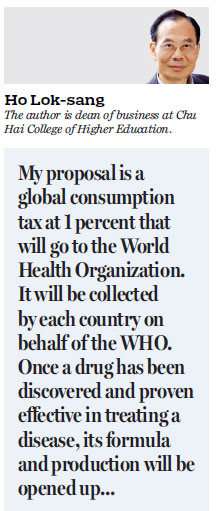A possible solution to rare disease drug cost problem
Updated: 2018-11-06 08:20
By Ho Lok-sang(HK Edition)
|
|||||||
Ho Lok-sang looks at the high costs, role of drug companies, and other challenges involved in supplying drugs for patients with rare, often life-threatening diseases
It was big news for Hong Kong's patients who suffer from a rare disease called SMA (spinal muscular atrophy) when Chief Executive Carrie Lam Cheng Yuet-ngor announced that an agreement has been struck with the drug company that free drugs will be made available to them for the first two to three months. This new drug, called Spinraza, has been approved by the Food and Drug Administration in the United States and has been proven effective in relieving the symptoms of the disease and greatly improving the quality of life of patients. It is reported that the cost could be HK$6 million a year for the first year and HK$3 million each year in the second year and beyond. Presently there are 14 patients inflicted with SMA (Type I), and the total cost for them just for the first year alone would exceed HK$80 million.
SMA, of course, is not the only rare disease in the world. According to an article in Lancet, about 7,000 rare diseases exist, and concern about the cost of fighting these diseases led to the launch of a Rare Disease Day, specified to be Feb 28 each year, in 2008 by a non-governmental alliance of patient organizations called EURORDIS. The good news is that, for many, rare disease drugs that can dramatically improve the quality and span of life are available. The bad news is that all of these drugs, while available physically, are prohibitively expensive. All of these drugs are prohibitively expensive because the market is small, but development costs are high.
A drug called Glybera became the most expensive drug in the world in 2015. The cost for this medication is over $1.2 million a year. It is used in Europe to treat a condition called familial lipoprotein lipase deficiency. This illness affects just 1,200 people throughout Europe. But worldwide it is estimated that patients could reach 1 million. We can see that the number of "rare disease" patients may not be small at all globally. It is a pity that even when an effective drug has been found, only a handful of patients can gain relief.

This year, on the mainland, the movie Dying to Survive caught fire. The movie reflects widespread public discontent about high drug cost, and is based on a real story about someone who was charged with selling false medication because he smuggled cheap versions of a leukemia medication from India for resale to patients who cannot afford to buy the authentic drug from official sources. A good question is: When a cure for a disease is available, shouldn't it be widely used so that its social benefit can be maximized? But who is going to foot the bill for the drug? If the drug is sold cheaply, how can drug companies recover the cost of development and still net an appropriate return that will give them the incentive to develop better cures for diseases?
Although difficult to believe, I do have a solution. But I realize that getting from here to there will not be easy. Still, let me share my ideas.
My proposal is a global consumption tax at 1 percent that will go to the World Health Organization. It will be collected by each country on behalf of the WHO. Once a drug has been discovered and proven effective in treating a disease, its formula and production will be opened up, but drug producers must keep an auditable record of sales through doctor prescriptions. The company that developed the drug will be paid an amount reflecting the volume of global prescription sales. So the drug company will pocket the revenue from direct sales, plus an amount in proportion to global sales by all drug companies that produce that drug.
I can immediately point out the difficulties of implementing this plan.
First, how can we get so many countries to get together to agree on collecting the tax on behalf of the WHO? Presumably each country can charge for the administrative cost of the service. But people may not trust the government. It will be difficult for people to accept an additional percentage point in their consumption tax.
Second, can the WHO handle the task of calculating and repaying drug companies for developing the drugs according to the global prescription sales? Since there are thousands of drug manufacturers, the task is complicated.
Third, will drug companies agree to the amount of payout for each unit of the prescription drug from the WHO? And what are the metrics determining that payout? This is complicated mathematics because the cost of developing different drugs and the size of the markets are different.
The challenges for overcoming the difficulties are clearly huge, but I believe that with today's information technology and particularly developments in blockchain, the technical problems can be solved. It is the political hurdles that will prove very difficult to overcome. But my naive wish is that the thought that a rare disease could hit anyone and anyone's loved ones could motivate people to explore if this works and other solutions if it doesn't.
(HK Edition 11/06/2018 page9)